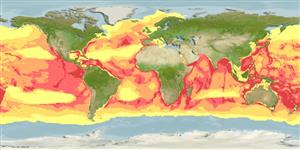Common names from other countries
Classification / Names / Names
Namen | Synonyme | Catalog of Fishes (gen., sp.) | ITIS | CoL | WoRMS
Environment: milieu / climate zone / depth range / distribution range
Ökologie
Pelagisch; standorttreu (Ref. 75906); tiefenbereich 0 - 1989 m (Ref. 116169). Tropical; 90°N - 90°S, 180°W - 180°E
Indo-Pacific, Atlantic Ocean and the Mediterranean. Tropical to warm temperate zones.
Length at first maturity / Size / Gewicht / Alter
Maturity: Lm ?, range 210 - 220 cm Max length : 270 cm TL Männchen/unbestimmt; (Ref. 1394); max. veröff. Gewicht: 210.0 kg (Ref. 1394)
Usually in deeper offshore waters. Typically in groups of less than 5 individuals (Ref. 801). Feeds on deep water cephalopods (Refs. 801, 1394) and crustaceans (Ref. 122680).
Females may become pregnant in successive breeding seasons. Mating occurs in summer. Calving lasts over 5 months (Ref. 97768).
Jefferson, T.A., S. Leatherwood and M.A. Webber. 1993. (Ref. 1394)
IUCN Rote Liste Status (Ref. 130435)
CITES Status (Ref. 108899)
Not Evaluated
Nutzung durch Menschen
Fischereien: kommerziell
FAO - Fischereien: landings, Artbeschreibung | FishSource | Sea Around Us
Tools
Mehr Information
Alter/GrößeWachstumLänge-GewichtLänge-LängeMorphologieLarvenDichte
Internet Quellen
Estimates based on models
Preferred temperature
(Ref.
115969): 2.4 - 13.9, mean 4.5 (based on 4397 cells).
Verwundbarkeit
Very high vulnerability (90 of 100).
Preiskategorie
Unknown.
